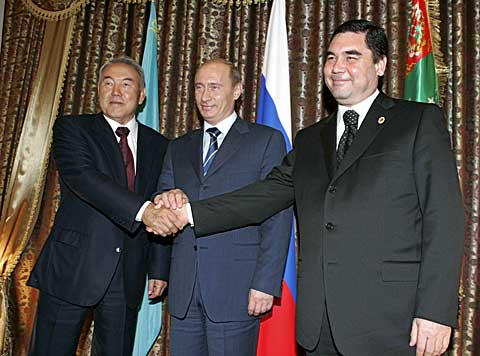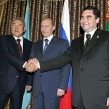
Russia Eyes Stronger Economic Engagement with Central Asia
Publication: Eurasia Daily Monitor Volume: 10 Issue: 24
By:

Russian authorities reiterated, on January 22, pledges of increased economic engagement with Central Asia. The foreign ministry advocated plans to develop economic and trade ties with the region, while other officials urged the creation of a Russian state corporation that would encourage economic development there (Regnum, January 22).
With their combined population of 65 million people, the Central Asian republics—Kazakhstan, Kyrgyzstan, Uzbekistan, Tajikistan and Turkmenistan—constitute a significant market, said Alexander Sternik, director of the Russian foreign ministry’s Commonwealth of Independent States (CIS) department. However, Russian trade with the Central Asian region currently amounts to only 3.7 percent of the country’s total foreign trade volume, he said in a speech delivered at the Russian Industry and Commerce Chamber.
According to official estimates, Russia’s exports represent 38 percent of Kazakhstan’s total imports, 34 percent of Kyrgyzstan’s and 24 percent of Tajikistan’s. Therefore, Russia’s commerce with Central Asian states must not go down and should be increased, Sternik said. Furthermore, the Russian foreign ministry official estimated that some 4.5 million Central Asian labor migrants currently live and work in Russia. These migrants transferred up to $9 billion to their home countries in 2012, he said (Regnum, January 22).
In the meantime, the United States’ investments in the region, notably in Kazakhstan, have been declining since 2007, Sternik noted. Yet, US economic involvement in Central Asia is expected to increase as soon as the economic situation in Europe stabilizes, he argued. “Our competitors do not remain idle,” he warned, pointing out that China’s commerce with the Central Asian republics amounted to some $45 billion per year, a 2.5-fold increase in the past five years (Regnum, January 22).
Moscow has pledged billions of dollars to support its allies in Central Asia. Russia has offered Kyrgyzstan and Tajikistan sizable loans and made multi-billion-dollar investment pledges to develop hydropower projects. Russia also has treaties of alliance and partnership with Kyrgyzstan and Tajikistan (see EDM, November 14, 2012; December 7, 2012).
Although Russian promises to fund hydropower projects were intended as incentives to mountainous Kyrgyzstan and Tajikistan, these pledges simultaneously served as irritants to upset the region’s lowland countries, notably Uzbekistan. Illustratively, in 2008, Tashkent suspended its membership in the Russia-led Eurasian Economic Community (EurAsEC) (RIA Novosti, November 12, 2008).
Moscow’s policies in Central Asia had previously revolved around the nexus of natural gas trade and transit issues. In 2008, Russia agreed to raise gas prices for Turkmenistan, Kazakhstan and Uzbekistan up to European levels from 2009 onward. The move was seen as a major financial incentive designed to keep Central Asian gas producers dependent on Russia’s pipeline network. But Russia subsequently limited gas imports from Central Asia and abandoned earlier plans to build new gas pipelines there (see EDM, December 15, 2009).
Along with bilateral dealings, Moscow has also been involved in attempts to create new regional multilateral institutions. Several years ago, Russia strongly advocated the creation of the Caspian Economic Cooperation Organization (CECO). The Caspian summit in Tehran in 2007 agreed to form the CECO. The new entity was expected to hold its first meeting in Russia in 2008, but would-be member states have made no further decision on the CECO so far (see EDM, April 16, 2010).
Moscow’s earlier attempts to take part in regional multilateral institution-building have brought limited results so far. In 2004, Russia formally joined the Central Asian Cooperation Organization (CACO), which includes Kazakhstan, Kyrgyzstan, Tajikistan and Uzbekistan. The CACO, founded in 1994, pledged to create a regional common market and free trade zone by 2009 (see EDM, October 11, 2005). However, in recent years, member states made few, if any, references to the CACO, while the regional common market still remains a distant vision.
Nonetheless, the Kremlin has continued to propose new plans for enhancing economic ties with its southern post-Soviet neighbors. Earlier this year, Russian officials floated an idea to create a Russian state corporation that would encourage economic development in Central Asia (Interfax, January 18). Viktor Ivanov, the head of the Russian Drug Control Agency, argued that the corporation would aim to develop new projects and create jobs in Central Asia, thus limiting drug consumption and trade. The proposed state corporation would cost 2 billion rubles ($66.5 million) to be created (News-Asia, January 21).
However, experts warned against a perceived threat of Chinese economic domination of Central Asia. China is already a predominant player in the region’s infrastructure sector, noted Kubat Rakhimov, co-author of the research project “Central Asia: New Coordinates,” which is due to be released in Moscow in February 2013. Beijing’s involvement in the region’s infrastructure projects indicates intentions to reorient exports of Central Asian resources toward China, the Russian expert remarked. In facing the Chinese “Anschluss,” Rakhimov argued, Russia should either increase its economic and military involvement in the region, or try to defend Kazakhstan’s southern border as a frontier of its economic and political interests in Central Asia (Iarex, January 21).
Moscow’s actions toward its southern neighbors give the impression of a renewal of the “Great Game” once played by Russia against the British Empire in Central Asia. This time, however, the geopolitical struggle may be aimed to counter not only Western influence, but also perceived Chinese economic encroachment as well.




